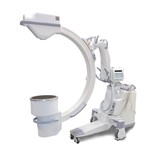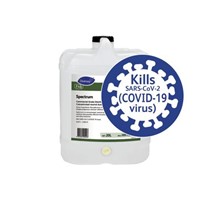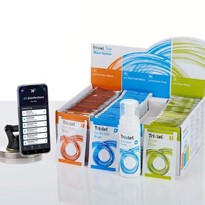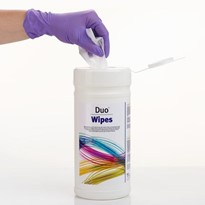When compared to traditional cleaning methods, wipes decrease the time to clean patient rooms by 23% and they reduce the human capital cost by around $50 per employee per day. Disinfectant wipes also significantly increase cleaning and disinfection compliance (Weimken 2014).
HAIs are a financial burden on hospitals that may be mitigated in some centres with a wipe-centric cleaning regime. But understanding how to optimise disinfectant wipe performance and keep usage costs under control is central to sustainable infection prevention management.
West (2018) studied the amount of disinfectant released by common disinfectant wipes and the efficacy over different sized areas. Perhaps unsurprisingly, the greater the area wiped, the less disinfectant is applied per square metre. Certain chemistries will see their efficacy drop off markedly as the amount of disinfectant applied to the surface decreases. Notably, accelerated hydrogen peroxide and chlorine disinfectants did not have this issue.
Counterintuitively, West found that the wettest wipes had the worst performance against Staphylococcus and Pseudomonas, with up to 2 log less of kill. This suggests that there is an optimal balance between the amount of disinfectant released and the mechanical action.
A new study by West, Teska & Oliver (2019) demonstrated that once a wiped surface is dry, there is no additional disinfectant efficacy. Thus in order to achieve maximum efficacy, the contact time needs to be shorter than the dry time. It has previously been thought that some actives like quaternary ammonium might continue to be bactericidal even when the surface has dried. But this study does not support that thinking.
Choosing the right disinfectant wipe is important. Rutala & Weber (2014) suggest that the ideal disinfectant is one that is efficacious, non-toxic and surface-compatible. Polycarbonate surface damage from disinfection is one of the key challenges that hospitals face when using disinfectants. Jo et al (2019) found that some wipe materials damage surfaces by creating microscopic linear scratches. Those scratches become prone to chemical attack ingress and cracking subsequently occurs.
Thus it is important that wipes not deliver more disinfectant than is needed to keep the surface wet for the contact time. Excess wetness does not equate to better efficacy. And prolonged contact can damage surfaces. Jo contends that surfaces may need to be wiped dry or even rinsed in a second step to minimise the risk of damage if certain disinfectant wipe products are being used.
The key to productivity, positive patient outcomes and longevity of equipment life is to select a disinfectant wipe that is efficacious in a short time, has a good safety profile for human exposure and is compatible with polycarbonates and stainless steel.
Surface disinfection must be considered alongside hand hygiene to adequately address the risk of infection for patients. While currently little data exists to support the frequency with which this must occur, current practices result in the patient bedrail being touched upwards of 256 times per day, while surface disinfection is done once per day with a 50 percent frequency. All healthcare facilities need to address the other 255 contacts with a consistent, well described program for patient zone infection prevention. The latest evidence supports disinfectant wipes as a significant advance in cleaning the patient zone and that those hospitals already using wipes are well and truly on the right track.
Ivan Obreza is the Healthcare Sector Leader at Diversey Australia and can be reached at [email protected].
www.diverseyvericlean.com
References:
- Jo H, West A, Teska P, Oliver H & Howater J Assessment of Early Onset Surface Damage From Accelerated Disinfection Protocol ARIC 2019; 8-24
- West, A, Nkemngong C, Voorn M, Wu T, Li X, Teska P & Oliver H Surface Area Wiped, Product Type, and Target Strain Impact Bactericidal Efficacy of RTU Disinfectant Towlettes ARIC 2018; 7-122
- Rutala W, Gergen M & Weber D Efficacy of Improved Hydrogen Peroxide against Important Healthcare Associated Pathogens ICHE 2012; 11-1159
- Rutala W & Weber D Selection of the Ideal Disinfectant ICHE 2014; 7-855
- Weimken T, Curran D, Pacholski E, Kelly R & Carrico R The value of ready-to-use disinfectant wipes: Compliance, employee time, and costs AJIC 2014; 42-329






-160x160-state_article-rel-cat.png)


















-205x205.jpg)




